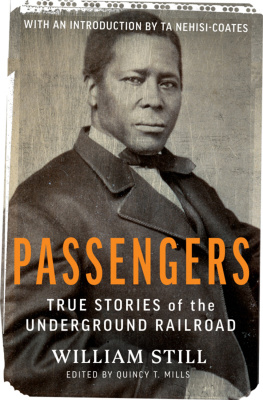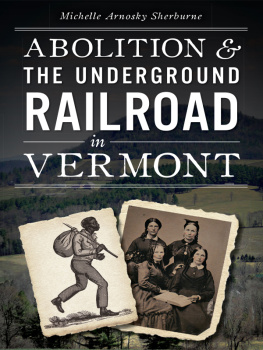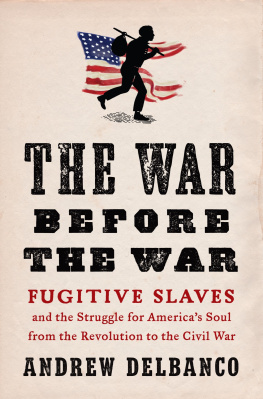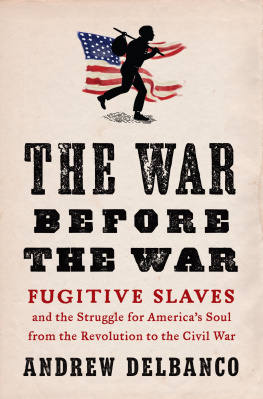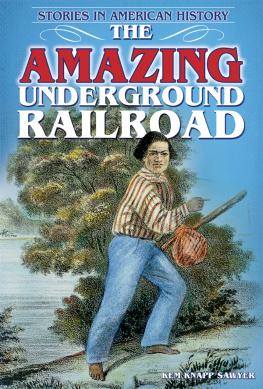2013 The University of North Carolina Press
All rights reserved
Set in Minion and Bodoni Poster Compressed
Manufactured in the United States of America
The paper in this book meets the guidelines for permanence and durability of the Committee on Production Guidelines for Book Longevity of the Council on Library Resources.
The University of North Carolina Press has been a member of the Green Press Initiative since 2003.
Library of Congress Cataloging-in-Publication Data
Blackett, R. J. M., 1943
Making freedom : the Underground Railroad and the
politics of slavery / R.J.M. Blackett.
pages cm. (The Steven and Janice Brose lectures
in the Civil War era)
Includes bibliographical references and index.
ISBN 978-1-4696-0877-8 (cloth : alk. paper)
ISBN 987-1-4696-0878-5 (e-book)
1. Fugitive slavesUnited States. 2. Fugitive slavesLegal status,
laws, etc.United States. 3. Underground Railroad. 4. United States.
Fugitive slave law (1850). 5. SlaveryPolitical aspectsUnited States
History19th century. 6. SlaveryUnited StatesLegal status of
slaves in free states. 7. United StatesPolitics and government
18151861. I. Title.
E450.B59 2013
973.7115dc23
2013009243
17 16 15 14 13 5 4 3 2 1
Preface
Many years ago, while working on a study of the role African Americans played in the transatlantic abolitionist movement, I ran across William and Ellen Craft, former slaves who were enormously popular with British audiences. Following up their story, I discovered that they had escaped from slavery in Macon, Georgia, over the 1848 Christmas holidays. Ellen, who looked white, dressed as an invalid slave master, and William accompanied her as her slave. Within four days they were being hidden by sympathizers in Pennsylvania, where they spent a few days before moving on to the relative safety of Boston. There they established a life for themselves, a life that was shattered when, in October 1850, two slave catchers from Macon appeared, seeking to return them to slavery. All the evidence suggests that their former owner had long known where they were yet chose to wait until the passage of the Fugitive Slave Law two weeks earlier provided additional license to retake them. Much more draconian that the earlier version, the 1850 law unleashed political passions that few anticipated. At public meetings throughout the North, people pledged to defy the law; others saw it as nothing more than a means to reaffirm a pledge made by the founding generation. The South looked on wearily, deeply skeptical of the Norths willingness to enforce what many saw as the last best chance to keep the Union together. The law, for all intents and purposes, nationalized the political debate over slavery. As if to thumb their noses at the law, the enslaved continued to escape in increasing numbers. In so doing, they actively joined the debate over the future of slavery. In this volatile political climate, the Crafts, and many other fugitives, became symbols of defiance and a yearning to be free. The pledge by the Boston black community and white supporters to protect the Crafts at all costs, in defiance of the law, only added to the sense of political crisis. The slave catchers were threatened physically and followed wherever they went by crowds of African Americans. In a coordinated effort, they were simultaneously sued by white members of the local Vigilance Committee for violating a number of ordinances. It is not clear that these suits had any legal merit; they were simply another way to intimidate the two Georgians. In the end, fearful for their safety, they returned to Georgia empty-handed. Although the attempt to recapture the fugitives had been repelled, supporters of the Crafts thought it best for the couple to leave the country once the president had publicly pledged his commitment to enforce the law at all costs and to punish those who resisted. By the end of the year, the Crafts were on their way to England, where they remained until 1869 when they returned to a United States free from slavery.
About ten years ago I decided to try to make sense of the political turmoil that followed in the wake of the Fugitive Slave Law by looking at how communities on both sides of the slavery divide organized to either resist or support enforcement of the law, and how slaves either entered or influenced the debate over the future of slavery by the act of escaping. Wanting to be as comprehensive as I possibly could, I made the rather foolish decision to cover the area from Virginia and Maryland in the east to Missouri in the west and north through the Free States to Canada. Having collected a mountain of data, I struggled over how the materials should be presented. The kind invitation from William Blair, director of the George and Ann Richards Civil War Center at Penn State University, to give the annual Brose Lectures in March 2012 forced my hand. My marching orders from Blair were simple enough: reevaluate the Underground Railroad. To do so, I chose to follow the trail laid out by the case of the Crafts. It is the Crafts who fashioned and executed their escape. Once they arrived in Pennsylvania, they were protected by members of the UGRR network who sent them to Boston. The passage of the Fugitive Slave Law and their former masters attempt to retake them threatened to destroy their newly won freedom. They and their supporters chose to defy both their former owner and the law. Those who came to their aid considered the law morally indefensible, one that had to be resisted. Supporters of the law thought otherwise: it was the law of the land and as such had to be obeyed and enforced. Defiance of this lawor any other law for that matterthey insisted, would set the country on the road to anarchy. I have added another feature to the discussion of the UGRR, one that was not a part of the Crafts case, namely, the efforts of slaverys opponents to undermine the system by going into the South and enticing slaves to escape. Taken together, these were the vital elements of the UGRR. This approach takes its cue from William Still, the driving force in the Philadelphia Vigilance Committee, who opened his monumental history of the movement in the cityThe Underground Rail Road, published in 1872, a history replete with scores of fugitives who acted on their ownwith an account of Seth Concklin, a white northerner who went south to bring out members of Stills family and who died for his pains. Slaveholders did what they could to protect themselves against such incursions. They may have felt under siege and hemmed in by the movement to destroy slavery, but we should never underestimate their ability to defend their interests and to stymie opponents. Escaping slavery and being involved in the UGRR was dangerous business.
My thanks to my old friend, Martin Crawford, who read and commented on the original draft; to the surprisingly large audiences who turned out, even on an unusually warm Saturday afternoon in March in Central Pennsylvania, and prodded me with questions about my findings; to the many archivists and librarians who responded promptly to my enquiries for information on local events and the people who were involved; to the very helpful staff of the Inter-library loan office at Vanderbilt University, who had a knack for finding me what I needed; and finally to my research assistants, Renee Stowitzky, Alexandria Cartaya, and Paula Gajewski, who took time out from their summer breaks to accompany me to libraries and places not normally found on tourists maps. During these trips we talked history, drank beer, and many times found gems of information we could not have anticipated. The final draft of the first chapter benefited from the comments of Ira Berlin and David Blight and questions from the audience at a session of the 2012 conference of the Organization of American Historians.



